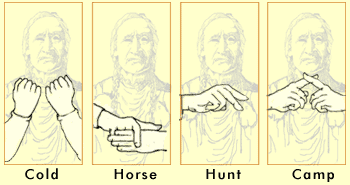

-The History of Deaf Communication and-
Kendall Green
The Beginnings of Deaf Communication in America
The roots of Kendall Green's Deaf Culture can be found in France, Scotland, Connecticut, a small island off the coast of Massachusetts, and Washington, D.C. itself. Two main schools of thought shaped American Deaf Culture. One, epitomized by Alexander Melville Bell, was a system of articulation (or speech) for the deaf. The second, epitomized by Thomas Hopkins Gallaudet and Laurent Clerc at the Hartford School for the Deaf, was the pursuit of common sign language that could be shared by all Americans.

Native American Sign Language (NASL)
For thousands of years, Native Americans have communicated with sign language. Pre-Columbian Native Americans had extensive trading networks involving the more than 500 tribes living in North America. Most of these tribes had their own distinct spoken languages. Native American Sign Language evolved as a common language among these tribes and the primary method of communication for trade and commerce.
In addition, many historical sources point to a high rate of childhood deafness among Native Americans. Sign Language was used within tribes to communicate with deaf members. It is not known precisely when Native American Sign Language developed but by the time the first colonists arrived in North America, Native American Sign Language was well established and widespread.

Martha's Vineyard Sign Language (MVSL)
Beginning in 1714 and continuing for over two hundred years, the islanders of Massachusetts' Martha's Vineyard communicated in both English and a sign language specific to the community. This sign language developed because of communication needs specific to the island community. Many of the families living on the island carried a recessive gene for deafness. As a result, there was a much larger percentage of deaf people on the island than in America in general and many families had both deaf and hearing members.
For many years, sign language was used on a daily basis by both hearing and deaf islanders. Virtually everyone signed. However, eventually a number of factors led to the decline of Martha's Vineyard Sign Language. One was the founding of the Hartford School for the Deaf in 1817 by Laurent Clerc and Thomas Gallaudet. The Hartford School quickly became the center of American deaf culture and it drew many deaf islanders to the mainland. At the Hartford school, island students came into contact with other forms of sign language which diluted the importance of MVSL. Furthermore, with a smaller pool of those genetically deaf remaining on the island, the need for MVSL diminished. By 1952, MSVL died out. Its influence lives on, however--it has become part of the system of signs known today as American Sign Language.



Thomas Hopkins Gallaudet, the father of American Sign Language
(1787-1851)
Thomas Hopkins Gallaudet was a pioneer in the education of the deaf. With Laurent Clerc, he founded the first school for the deaf in America, the Hartford School for the Deaf. A graduate of Yale with a degree in Education, Gallaudet became interested in deaf education when he was hired to teach Alice Cogswell, a young deaf girl. To help Gallaudet gain the skills he needed to teach a deaf pupil, Cogswell's parents paid Gallaudet to travel throughout Britain to study the education methods at the Braidwell schools for the deaf and to Paris to study the methods of L’Institut National de Jeunes Sourds (The National School for the Deaf). In Paris he met Laurent Clerc, a young deaf teacher fluent in Parisian sign language. Clerc accompanied Gallaudet back to Hartford, where they devoted their lives to better educating the deaf and to developing a form of sign language that would work for their American students.
Laurent Clerc, the father of American Deaf Culture
(1785-1869)
Laurent Clerc is considered by some to be the father of American Deaf Culture. A Frenchman by birth, Clerc lost his senses of hearing and smell at the age of one as the result of a fall. Clerc was educated from the age of 12 at L’Institut National de Jeunes Sourds (the National School for the Deaf) in Paris. Here he learned to sign and was exposed to literature and history. A series of unpleasant encounters with an articulation (speech) teacher left Clerc with a dislike of speech and speech instruction. After his graduation from L’Institut, Clerc became a teacher of the deaf. In 1815, he met Thomas Hopkins Gallaudet in Paris. Gallaudet quickly hired Clerc to tutor him in signing and the two became friends. Gallaudet was so taken with Clerc that he offered him a job in Hartford. Upon Clerc's arrival in America, he immediately began teaching deaf students, eventually co-founding the Hartford School for the Deaf. Clerc continued teaching for the next forty one years. As a teacher, role model and patriarch of a deaf family, Clerc had an influence in Deaf Culture and American Sign Language that is still felt today. By one count, approximately 58% of ASL is based on Clerc’s teachings.
Alexander Melville Bell and the Visible Speech System
(1819-1905)
Alexander Melville Bell was a famous public speaker and educator. Born in Scotland, Bell eventually settled in America. An expert in physiological phonetics, Bell invented the Visible Speech method of elocution. Originally designed to assist public speakers in communicating more clearly, Visible Speech became a successful method for teaching the deaf to speak. Visible Speech is a system of 29 modifiers and tones, 52 consonants, 36 vowels and a dozen diphthongs. In 1864 Melville published his first works on Visible Speech. Bell married a deaf woman and went on to publish seventeen works on proper speech, vocal physiology, and stenography and to devote himself to Deaf Education. He is the father of Alexander Graham Bell.